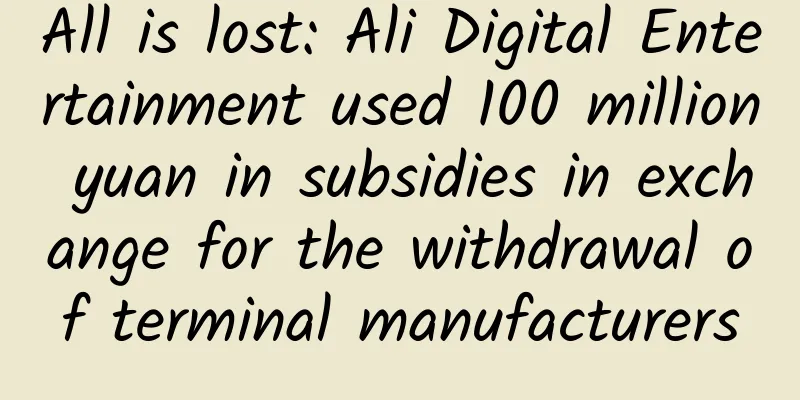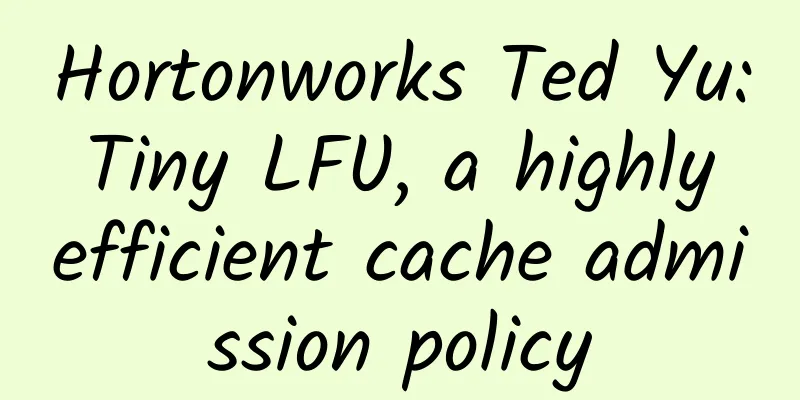All is lost: Ali Digital Entertainment used 100 million yuan in subsidies in exchange for the withdrawal of terminal manufacturers

|
Although Alibaba Digital Entertainment experienced huge personnel changes some time ago, Alibaba's ambitious living room ecosystem strategy is still advancing in an orderly manner, and the previously established hardware terminal subsidy policy is still in effect - any manufacturer that installs the YunOS system in a TV box can receive a subsidy ranging from 20 to 60 yuan per unit. On the surface, this seems to be a win-win deal. Alibaba Digital Entertainment, a major financial backer, pays to buy the market, while TV box manufacturers make a lot of profit. However, in Shenzhen, where TV box manufacturers gather, the news is quite different. A box manufacturer from Shenzhen said helplessly, "This is not good. Alibaba's subsidies have killed everyone." In the past two years, Alibaba Digital Entertainment has subsidized 70% of the OTT terminals in the market to YunOS through its subsidy policy for TV box manufacturers. According to incomplete statistics, about 20 million TV boxes were sold in my country last year. This seems to be a difficult paradox. Why are the big money sponsors almost killing everyone? Why did the hardware manufacturers go from chasing subsidies at first to feeling uneasy later and now wanting to withdraw? Alibaba's huge subsidies are all used in price wars Before Alibaba Digital Entertainment launched its huge subsidy policy, manufacturers in Shenzhen, a hub of TV box production, were facing transformation, and many motherboard manufacturers began to transfer their accumulated inventory to boxes. In 2013, the gross profit of each box was still maintained at more than ten yuan. In 2014, as more people entered the market, the profit dropped to five or six yuan. At this time, Alibaba Digital Entertainment's subsidy policy was introduced. For each TV box pre-installed with YunOS, Alibaba would subsidize the device manufacturer with 20 to 30 yuan when the user turned on the system to activate it. If Taobao and Alipay were also installed, the subsidy would be 40 to 60 yuan. Last year, due to policy reasons, the domestic TV box market encountered a cold winter, and sales were almost halved. In order to survive, box manufacturers regarded Alibaba’s subsidies as a life-saving straw. From an outsider's perspective, as long as the subsidies are received, manufacturers can make more money. However, the fact is that due to the existence of high subsidies, the number of manufacturers joining the TV box manufacturing industry has begun to increase, and these subsidies are ultimately used by manufacturers to engage in price wars. "My box originally sells for 140 yuan, and yours also sells for 140 yuan. If I received a 30 yuan subsidy from Alibaba Cloud, most manufacturers would sell the 140 yuan box for 110 yuan, hoping to crush their competitors through price. However, seeing this situation, competitors who could have remained independent had no choice but to beg for subsidies at Alibaba's doorstep, or else they would die." A Shenzhen TV box manufacturer described the market situation to CNN. The source added, "Because of the subsidies, everyone is keeping prices very low now, and no one dares to raise prices, so the profit margin is actually being squeezed." At a glance, this matter does not seem to have a direct relationship with Alibaba Digital Entertainment. It seems that Alibaba only provided subsidies, and it was the major TV box manufacturers in Shenzhen that ultimately carried out the irrational price war. In fact, this is not the case. Because in the terms of the subsidy policy, Alibaba has requirements for the sales volume of the boxes of the manufacturers, and only when they sell enough can they get the corresponding subsidies. This is just like what Didi drivers complain about nowadays: "Didi requires us to complete 15 designated orders a day. If we don't complete them, there will be no subsidies. Now we part-time drivers are just like professional drivers, leaving early and returning late just to complete those 15 orders. I will quit next month and go back to work honestly. The money is not easy to make." There is always a stick hidden behind the carrot, and Ali is undoubtedly the hunter wielding the stick. A box manufacturer said, "If the annual shipment volume is 500,000, it means that the manufacturer has to sell 30,000 to 40,000 units a month. This is very stressful for small manufacturers. In order to maintain the volume and get subsidies, they can only lower the price. In the end, they find that it is better not to have subsidies, and everyone is competing in an orderly manner." The carrot and stick approach ultimately led to a bad consequence, that is, no one benefited. In this seemingly lively subsidy drama, every participant was hurt, especially Alibaba, which spent hundreds of millions of yuan but ended up with a bad review. This was definitely not Alibaba's original intention. What’s even more frightening is that in the end everyone realizes, “What I sell is exactly the same as what you sell. There is no differentiation at all.” "In fact, Shenzhen manufacturers driven by profits are extremely sensitive and have their own barometer of the market. Take a look at Shenzhen's local consumer newspapers. Last year, TV boxes took up seven or eight pages of advertisements, but this year it only took up half a page, while dash cams and sports DVs took up seven or eight pages." An industry investor told . According to the survey, small and medium-sized manufacturers in Shenzhen are now reluctant to get involved in the OTT market, while large manufacturers have also begun to seek transformation. For example, Inphic has begun to invest in products such as driving recorders and sports DVs. The TV box market, which has lost its profits, has begun to cause manufacturers to flee. A good game of chess was defeated In the Internet industry, there have always been two successful models, one is the Apple model and the other is the Google model. In Apple's industrial chain, Apple is in charge of everything from the source of OS to production and manufacturing to sales. Google's Android is an extremely open system, while the management of other mobile phone brands is entirely the responsibility of the manufacturers themselves. "Why did Alibaba spend a lot of money but didn't get any good reviews? Where is the dignity of the rich?" Analysts believe that referring to the two models of Apple and Google, it can be seen that Alibaba YunOS's entire subsidy system combines Apple and Google, but only does half of each, and this half is full of shortcomings. YunOS imitates Apple, controlling OS and content, but omitting manufacturing and sales, causing hardware manufacturers to become OEM factories for Alibaba YunOS. YunOS follows Google's example and licenses its OS to everyone for free (or at a cost), but it has not been able to provide strong support to developers, and its ecosystem has not been able to take off. There are excellent players like MIUI based on the Android system, but YunOS has always been the only one under its command. In addition, when Alibaba took over the OTT market, it did not do quality control. If there is a problem with the product, it is still the manufacturers who have to deal with it themselves, regardless of whether some small manufacturers have perfect after-sales capabilities. In short, YunOS lacks neither the openness of Android nor the ecosystem of Apple. "Many of our peers no longer use YunOS this year, and we don't want to use it anymore. The market is very chaotic, everyone's content is the same, and it's hard to sell," said a hardware manufacturer. “When Alibaba first started, it made a good move by quickly taking over the chaotic market for off-brand box products. However, after aimlessly subsidizing and grabbing land, it failed to have good enough operations and development capabilities, which disrupted the plan and hurt everyone,” analyzed an industry insider. Faced with the wildly growing OTT market, the task that Internet giants undertake is not as simple as grabbing land, but more responsibility lies in actively guiding the entire industry. Giving up brands, price control, quality control, and developer maintenance in order to grab land will only lead to chaos in the industry chain. In the first half of 2014, the domestic TV box market was still in a healthy development period. One manufacturer was on the verge of bankruptcy because it had stockpiled a large number of low-priced and low-quality chips and motherboards, which led to poor sales. However, it later enjoyed subsidies from Alibaba and began to take the route of low-price dumping, which instantly became strong, leaving its peers in the industry crying out that they couldn't understand it. In order to increase shipments, this manufacturer played a trick that violated technical iteration in the configuration of the box, using an 8-core CPU with 512M memory, thus beating other manufacturers in total price, and eventually successfully digesting its inventory, deceiving countless consumers. What is even more frightening is that Alibaba is indifferent to this, it only cares about sales, so until today, it still supports this manufacturer as a key brand. As a result, most manufacturers with brand awareness and R&D capabilities have collectively fled YunOS, or simply fled the TV box market. YunOS is a headache for CP Although there are reports that some Alibaba veterans initially disdained this subsidy policy, believing that Alibaba, which has the world's largest sales channel, is using cash subsidies to smash the market, which is "very shameful." "Ali doesn't understand many things internally, and there is a lack of communication between departments. Under the pressure of KPI, abnormal and crude means will be adopted," an industry insider analyzed. A few months ago, we published an article titled "Blindly Encouraging Application Development, Alibaba May Lead Developers into a Vicious Circle", in which we discussed how Alibaba's eagerness to enter the market has led developers into a vicious circle of blind development. So what is Alibaba YunOS like on TV? "From a developer's perspective, YunOS for TV is not user-friendly. We can't find its developer website, nor is there developer documentation, so it's difficult to adapt the product. Hardware manufacturers still have to be a little bit differentiated, and they will make underlying modifications to Alibaba's ROM, which causes different problems for an application on different boxes. Usually when you encounter a problem, you'll be told to find the corresponding box manufacturer, but the person in charge of the manufacturer is often powerless to help," a CP told. On the other hand, Alibaba YunOS's "unified terminal" has completely eliminated the differences in the TV box market, resulting in 70% of the TV boxes on the market being similar. "The subsidies have also caused the channel value of the boxes to be seriously underestimated. Most of the boxes are now sold in electronics markets. Dealers will receive offline training after receiving the goods, and sales staff need to demonstrate the contents of the boxes to consumers. Therefore, as long as there is content, generic boxes are very willing to take them. This makes the manufacturers who once put a lot of effort into building their brands very helpless. In any case, in the eyes of users, the interfaces and content of the two are similar." described a CP. "This bad result has caused us CPs to find that when we talk to hardware manufacturers about pre-installation, we will find that small manufacturers are not willing to play, and large manufacturers will ask you for money, and will not install if you don't pay. Without the hardware bonus, they will find other channels to make profits. This will kill the enthusiasm of most practitioners. This is probably the most far-reaching and worst impact caused by the implementation of the subsidy policy. After all, it is unreasonable for channels to take advantage of CPs before the industry has taken off. Everyone is going through the winter, and if you steal my cotton-padded jacket, I will die. Without content, your channel will not survive either." A subsidy has forced the industry into a vicious cycle of revenge, which no one could have expected. This is also the fundamental reason why many box manufacturers in Shenzhen are unwilling to continue to accompany Alibaba. If you look closely at the current Internet industry, you will find that "land grabbing movements" for emerging industries are everywhere, and Internet giants are trying to solve all problems with money. However, due to the disdain for the industry, the misjudgment of the market, and the superstition of KPI, many grassroots manufacturers have become victims of the competition among giants. However, the driving force of the market activity often comes from these grassroots manufacturers. "In fact, Alibaba Digital Entertainment could have taken more paths, such as helping small manufacturers provide differentiated services, optimizing product experience, and guiding product development. Now the environment is bad, and it is too difficult to remedy the situation," said the industry insider. "It is difficult to reverse what has been done. We don't plan to continue." As a winner of Toutiao's Qingyun Plan and Baijiahao's Bai+ Plan, the 2019 Baidu Digital Author of the Year, the Baijiahao's Most Popular Author in the Technology Field, the 2019 Sogou Technology and Culture Author, and the 2021 Baijiahao Quarterly Influential Creator, he has won many awards, including the 2013 Sohu Best Industry Media Person, the 2015 China New Media Entrepreneurship Competition Beijing Third Place, the 2015 Guangmang Experience Award, the 2015 China New Media Entrepreneurship Competition Finals Third Place, and the 2018 Baidu Dynamic Annual Powerful Celebrity. |
<<: UK new car production and growth rate from Q1 2019 to Q2 2020 (with original data table)
Recommend
Introduction to the promotion and material specifications of Sync Assistant flash screen advertising!
1. Sync Assistant Splash Screen Ads Displayed to ...
What is the appropriate bid for Pinduoduo keywords? What is the bidding method?
Through Train is not only a promotional tool that...
Analysis of explosive materials and landing pages in 6 hot investment industries!
The more exaggerated, the more explosive? Totally...
Why do so many brands do year-end reviews, and NetEase and Alipay dominate the screen?
It is the end of the year again, and brands from ...
Tumen SEO Training: How to analyze competitors' websites and where to start?
Competitors stand, only by standing on the should...
Don't sleep, wake up! I'm hibernating
Have you noticed that after a large wave of rainf...
Beijing Internet Speed Evaluation Report: 10M Bandwidth is Actually Only 3M
2014 marks the 20th anniversary of China's Int...
Is iOS/iPadOS 14 worth upgrading? Just read this article
After three months of testing, the official versi...
Pan Ya Pan Pan Photography Tutorial 2020 [Good quality only video]
Pan Ya Pan Pan Photography Tutorial 2020 [Good qu...
Advertising case study: how to reduce the cost of leads by 50%?
Today I would like to share with you a case study...
Liu Heng's I Ching: Lectures on Physiognomy
Liu Heng's Physiognomy Lecture Room Resource ...
Dismantling the operation and promotion strategies of 360, Xiaomi, WeChat and Oasis
What I will share today are the product operation...
Why are plagiarized short videos more popular than original ones? Why is your copy not popular?
Some people always feel that the whole world is a...
BYD released the Honor Edition Han Tang, and taught Xiaomi how to build cars. The industry officially entered the knockout round
Just after the Spring Festival, BYD dropped a bom...
College Entrance Examination Chinese Essay Forecast 2020 College Entrance Examination Chinese Essay Material Reference on Epidemic
During the Spring Festival of 2020, the new coron...









